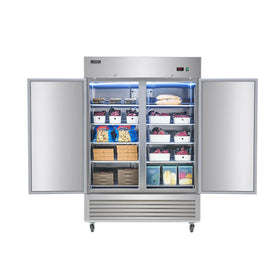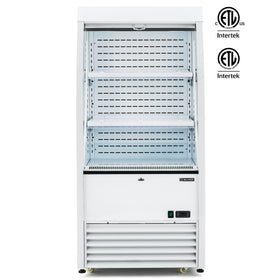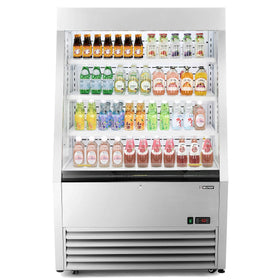When choosing a commercial oven for your bakery, you have to do everything to ensure that you are getting the best commercial oven your budget can afford.
The commercial oven is at the center of everything that goes on in a bakery, and it determines everything, from the quality of your breads and pastries to the speed and overall efficiency at which you are able to operate.
To help you choose the best commercial oven for a bakery, we are detailing everything you need to know as you look to make up your mind. You will find out which features matters, why overlooking it could be a risk for your business, and what to look for when buying.

How to Choose the Best Commercial Oven For Bakery
1. Decide on the Type of Oven You Need
Not all commercial ovens are the same, and different types of baked goods require different heating methods. Therefore, the type of commercial oven you choose must be the best match for the kinds of pastries and breads you are making at your bakery.
Choosing the right type of oven ensures that you can achieve the proper rise, crust, or texture, and even explore more variety to offer at your bakery.
- Choose a commercial Convection oven for pastries, cookies, and cakes
- Choose deck ovens for artisan bread and pizza
- Choose rack or rotary ovens for large-scale baking
Overall, when you are in doubt, go for a convection oven. Convection ovens are generally preffered over most other types because they are more efficient at distributing heat. This is important in a bakery where you are likely to be baking a multitute of (usually) smaller items simultaneously.
2. Estimate the Required Oven Size and Capacity
For any bakery, the size of your oven must be able to accommodate the volume of products you bake daily. That is where oven capacity comes in.
If your oven is too small, your team will struggle to keep up with demand. Too large, and you’ll overspend on energy and space.
So, to choose the right-sized commercial oven for a bakery, consider the size of the bakery, the average daily customer flow, and the amount of space you have available.
Oven Size Chart for Bakery
| Bakery Size | Approx. Daily Production | Typical Customer Flow | Recommended Oven Size | Why |
| Small Bakery | Up to 200-500 items/day | Under 100 customers/day | About 1 cu.ft. | Ideal for low-volume, specialty baking (e.g., small artisan batches, home-based or boutique bakeries) |
| Medium Bakery | 500-2,000 items/day | 100–300 customers/day | About 7 cubic feet | Offers decent batch size and flexibility for a wider menu. Suitable for bakeries serving moderate customer flow or supplying small businesses like cafés. |
| Large Bakery | 2,000+ items/day | 300+ customers/day or wholesale supply | 14 cubic ft | Large enough to support high-volume production and multiple batch cycles efficiently. Also fits businesses with wholesale operations or high-footfall retail chains. |
- Smaller commercial ovens (<1 cu ft) are best for supporting artisanal, made-to-order, or niche operations.
- Mid-sized ovens (around 7 cu ft) allow steady production for a local customer base or multiple daily batches.
- Large ovens (10+ cu ft) are built for high turnover, supplying multiple outlets or large retail demand.
- Also, the oven must fit within your available kitchen space while leaving some space to open and close.
Check the number of trays, decks, or racks it can handle, batch turnaround times, and ensure the unit fits smoothly within your layout.
3. Heat Distribution and Consistency
Consistent, even heat is crucial for a commercial oven because it ensures that every product comes out properly baked, with uniform color, rise, and texture.
So, when you buy a commercial oven for a bakery, you want a unit that provides uniform airflow systems, even deck materials, multizone heating, and has good customer reviews.
- Heat distribution is especially important when you are dealing with multitudes of products that have to be baked at once, which is why a convection oven is always better for bakeries.
- Convection ovens come with fans that spread and distribute the air evenly around the interior of the oven for better heating.
With convection ovens, there is less risk of burnt bottoms, pale tops, uneven rise, or undercooked centers, which can lead to waste and customer complaints.
4. Temperature Control and Range
Precision is key when working with delicate pastries, specialty breads, or items requiring sudden burst heat or steam. For your bakery, look for a commercial oven with a wide temperature range, quick recovery times, digital monitoring, programmable controls, and steam injection capability (for bread-heavy bakeries).
With a unit like this, you cannot struggle with consistency or find it difficult to diversify your menu.
5. Energy Efficiency and Operating Cost
Ovens run for long hours, so when buying an oven for a bakery, it is important to consider energy consumption and how it can significantly affect your long-term profits. Ideally, you have to choose between a gas oven and an electric oven.

Electric Commercial Ovens vs Gas Commercial Ovens: Which is More Energy Efficient?
Overall, electric commercial ovens tend to be more energy-efficient than gas commercial ovens in terms of how much of the input energy actually goes into cooking the food. For example, one study found average cooking efficiencies of about 78% for electric and about 55% for gas convection ovens.
Commercial Electric Ovens Face Stricter Energy Regulations
Also, the energy efficiency standards for electric commercial ovens are much stricter than gas commercial ovens. The ENERGY STAR program requires that full-size electric convection ovens must meet 76% cooking-energy efficiency, while full-size gas ones must meet ≥49% for certification.
Gas Commercial Ovens are Cheaper in the U.S
However, though electric ovens are more efficient, a gas commercial oven may actually be cheaper to operate than an electric commercial oven, especially if your bakery is in the United States. The actual operating cost of a gas commercial oven depends heavily on the local price of electricity vs gas. According to reports, natural gas is cheaper per unit of thermal energy than electricity in many U.S markets.
Whether you go for a gas commercial oven or an electric commercial oven, look for energy-efficient ratings, solid insulation, reduced idle consumption, and fast heat-up times to prevent high energy bills, which can lower your return on investment.
Other Important Factors When Buying A Commercial Oven For a Bakery
-
Look for Programmable Features: Look for touchscreen controls, preset recipes, and programmable timers to improve workflow and reduce training time.
- Durability and Build Quality: Look for stainless steel build with solid doors and a solid warranty. A bakery oven endures continuous daily use. This prevents frequent breakdowns and high repair costs.
- Check Maintenance and Cleaning Requirements: Find a unit that is easy to clean and maintain. The interiors must be easy to access, removable, self-cleaning or steam cleaning features.
- Brand Reputation and After-Sales Support: Look for strong support features that ensure quick fixes and long-term reliability. Look for a reliable brand with responsive customer support and accessible spare parts.

Best Commercial Ovens for Bakeries
For small bakeries, consider the 1/4 Pan countertop convection from Wilprep. It features a 0.9 cu. ft. (26 L) cavity and 3 wire racks to accommodate 3 quarter-size sheet pans, providing ample space and flexibility for tasks from toasting and roasting to baking and broiling.
With the 1440W heating power and uniform air circulation, this commercial convection oven cooks food faster and more evenly than conventional ovens.
Get your cooking just how you like or need it. Simply turn the knob to set temperatures from 100 to 500°F and durations of up to 120 minutes.
For Medium-Sized Bakeries
Wilprep’s commercial LPG convection oven single deck features a spacious 7-cu. ft. chamber with 5 racks that can rest on 11 sets of brackets. You can benefit from a variety of rack configurations to best accommodate your food, from cakes to pizzas.
Switch the convection fan between 2 modes (cook and cool modes) and 2 speeds (high and low) to ensure fast, even heating across a variety of recipes.
With 54,000 total BTU and an automatic thermostat, this LPG convection oven precisely reaches temperatures from 150 to 500°F for baking diverse foods. A liquid propane gas and a 120V electrical connection are required for operation.
Best Commercial Refrigerators for Large-Sized Bakeries
For large bakeries, consider the double-deck commercial convection oven from Wilprep. It offers a spacious 7 cu. ft. chamber with 5 racks that can rest on 11 sets of brackets.
With 10 kW of power from a 208V 3-phase outlet, this electric convection oven reaches temperatures from 150 to 500°F for baking diverse foods. It also operates with an automatic thermostat for reliable precision.
You can also switch the convection fan between 2 modes (cook and cool modes) and 2 speeds (high and low) to ensure fast, even heating across a variety of recipes.
Final Thoughts on Commercial Ovens for Bakeries
Choosing the right oven for your bakery ensures consistent product quality, efficient workflow, and long-term profitability. By considering not just what you bake today but what you may want to offer in the future, you can invest in an oven that grows with your bakery and supports its success every day.
Here are the top six uses of a convection oven that will maximize efficiency and minimize cost for your bakery.










